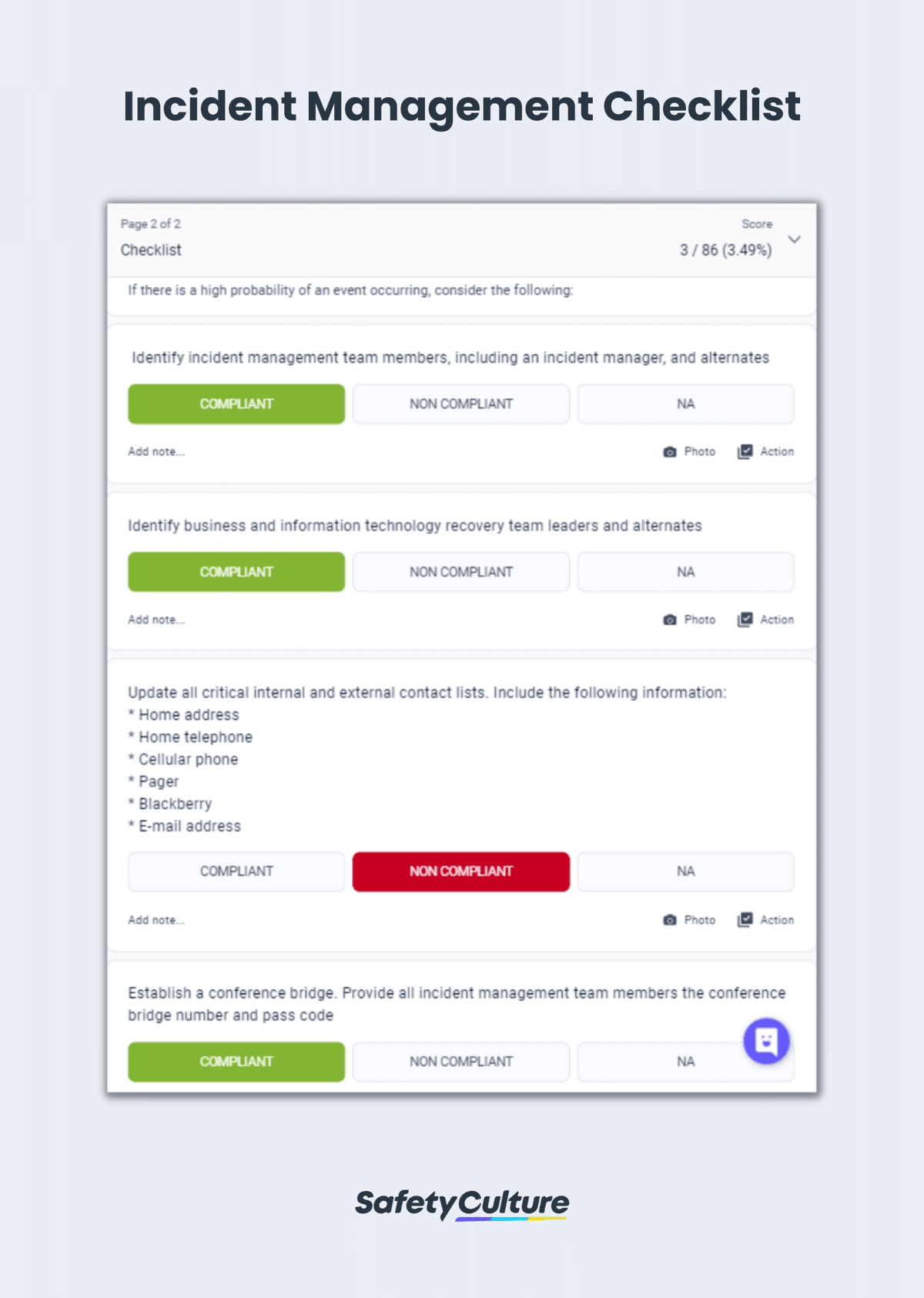What is Incident Management?
Incident management is the process of identifying and analyzing hazards and risks in order to come up with effective mitigation and control measures for an organization. This intends to limit incidents’ disruption to operations, minimize negative impact, and prevent recurrence. Incident management helps key stakeholders and IT teams investigate and resolve issues before they evolve into bigger problems.
Incident, Near-Miss, and Accident: What’s the Difference?
The terms are used interchangeably in some industries and all are caused by unwanted events. There are differences, however, according to OSHA and in the context of workplace safety.
Near Miss
Sometimes called a dangerous occurrence, a near-miss is an unplanned event that did not result in bodily harm, illness, fatality, or destruction of property but had the potential to do so. Reporting all near-misses in the workplace is crucial to helping operations fine-tune processes and eliminate or mitigate risks.
Reporting near misses with all the relevant information can also aid safety officers in formulating safety precautions that can address previously unforeseen hazards, prevent the recurrence of such incidents, and avoid more damaging events in the future.
Incident
An incident is an event that disrupts operations and hinders the completion of tasks. Incidents can also be potentially destructive events but, like near-misses, have not resulted in injury, death, or property damage. An incident may introduce hazards or risks to a business and its employees and negatively impact the organization. Inaction and failure to report or investigate incidents may result in their recurrence and lead to more serious repercussions.
Accident
Unlike an incident or near-miss, an accident is an undesired event that results in physical injury, illness, fatality, or property damage. Accidents and incidents are often considered to mean the same thing, but a distinction can be made based on their causes.
Accidents are random events that could not have been prevented, with no intended preventive measures in place to mitigate or avoid their occurrence. Incidents, on the other hand, are considered “predictable and could have been prevented if the right actions were taken.”
What is an Incident Management System?
An incident management system is the effective and systematic use of all resources available to an organization to respond to an incident, mitigate its impact, and understand its cause to prevent recurrence. It’s a combination of people’s efforts to utilize processes and tools to manage incidents.
People
This involves not only the company’s safety officers but all employees and stakeholders. Any personnel must promptly report any incidents they experience or witness to the appropriate authority to ensure a timely response and proper incident documentation.
Process
The incident management process involves implementing the following steps when an incident occurs:
- incident reporting
- corrective action
- investigation and analysis
- incident closure
Tools
This includes incident reporting tools like an incident report form, an incident management checklist, or an incident report app that helps immediately capture incident details and assign corrective action for swift response.
4 Steps of Incident Management Process
Here are major incident management steps that can be implemented in the workplace.
Step 1: Incident Reporting
The vital first step in incident management that makes an incident known and prompts corresponding action is incident reporting. All information that can contribute to understanding the incident should be collected and reported immediately.
What information to gather for an incident report:
When gathering information for an incident report, the person responsible for reporting should ask for the following:
- What type of incident happened
- Who are the people involved
- Where the incident occurred
- When the incident happened
- How severe is the incident, and, if possible, why the incident took place
The incident report can also include photos to help provide better context on the type and severity of the incident.
Incidents that result in property damage should be reported to insurers promptly to avoid delays or possible rejection of claims due to late reporting.
When to contact OSHA?
OSHA requires all employers to report an incident within 8 hours if it resulted in employee fatality or within 24 hours if an employee got severely injured. Severely injured means in-patient hospitalization, amputation, or eye loss.
Provide the following information when contacting OSHA:
- business name;
- names of employees affected;
- location and time of the incident,
- brief description of the incident; and
- contact person and phone number.
Create your own Incident Management Checklist
Build from scratch or choose from our collection of free, ready-to-download, and customizable templates.
Browse Incident Management ChecklistsStep 2: Corrective Action
Corresponding corrective actions should be applied to mitigate the negative impact of incidents and prevent recurrence. Corrective actions are ideally monitored to ensure that they are completed and that the desired outcome is achieved.
Step 3: Investigation and Analysis
To maintain smooth operations and workplace safety, businesses should implement controls that either eliminate the possibility of incidents occurring or mitigate their impact. If an incident does happen and it’s moderately impactful to the business or severe in nature, an investigation is required to gather more information that will be analyzed to get to the root cause of the incident and come up with better controls to implement.
Conducting a root cause analysis or following the CAPA process can help uncover possible safety gaps, get to the primary cause of an incident, and implement more proactive controls.
An incident investigation may entail the gathering of personal data of the people involved in the incident as well as sensitive information from documents, photos, and other media that can help provide a better understanding of the sequence of events that led to the incident.
Step 4: Incident Closure
The final step is incident report closure after checking if previous steps have been completed. Incident closure helps verify if the root cause of the incident has been determined, corrective actions were completed, and learnings were applied to improve processes to continuously fine tune safety measures in the workplace.
Improve your GRC management
Simplify risk management and compliance with our centralized platform, designed to integrate and automate processes for optimal governance.
Explore nowIncident Management Example
Using the steps above, we created an example scenario below to better illustrate the incident management process in action:
| Incident Reporting | |
| What type of incident happened? | An employee burned his hand while using a blowtorch. |
| Who are the people involved? | Aside from the affected employee, two of his coworkers were also present and had to stop work to call for aid. |
| Where did the incident occur? | The incident occured in the welding area of the facility. |
| When did the incident happen? | The incident occurred at 2:08 pm on February 18, 2022 (Friday). |
| How severe is the incident? And, if possible, provide what caused the incident. | The incident had severe consequences. The affected employee received third-degree burns and thus had to be hospitalized. It’s expected that he won’t be able to return to work for another month or so. The suspected reason for this incident is the lack of appropriate Personal Protective Equipment (PPE). The affected employee was also distracted by a notification from his phone (it was set to automatically emit a white flash of light whenever a notification is received). This distraction resulted in longer exposure to the flame. If exposure had been shorter, it’s possible that the affected employee would have received only second-degree burns. |
| Corrective Action(s) |
|
Using the same example scenario, the incident closure states:
| Incident Closure |
|
How to Improve the Incident Management Process
Incident management needs continuous improvement and here are some tips on how to do that:
Implement Cohesive Workflows
Establish a workflow that enables businesses to address crucial areas of incident management seamlessly. The main goal is to be able to respond to incidents and provide the correct solutions efficiently.
Prioritize Incidents
Emphasize the importance of assessing incidents and categorizing them according to their level of urgency. This ensures that critical mishaps that can significantly impact business processes are addressed first and solved as quickly as possible.
Consistent Reporting
Ensure timely incident reporting by making it easier to collect information and submit incident reports. A safety app like SafetyCulture (formerly iAuditor) makes it easier to capture information and submit incident reports anytime, anywhere, using mobile devices.
Action Follow-through
Persons responsible for completing corrective actions can provide feedback or status updates in real-time using SafetyCulture, making actions a collaborative effort in managing incidents.
Refresher Trainings
There is a need for periodic refresher training on safety and processes as industry standards and regulations evolve over time to cope with new safety risks and hazards. Reinforce safe practices by conducting training that address gaps discovered during analysis of incidents.




